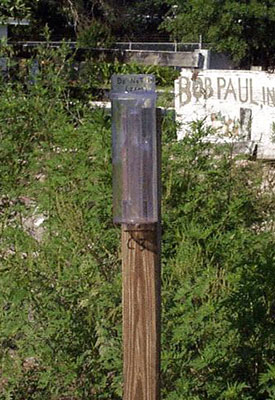Rain Gauges and Rain Sensors
Rain gauges and rain sensors are useful tools for weathering watching, and they can contribute to healthier plants, too. Irrigating the garden is only necessary when rainfall isn’t adequate. So it’s always a good idea to keep track of how much rain your landscape is getting.
Keep in mind that the water needs of plants can vary, depending on the season and the landscape. But many plants need at least some water every week during the warm months.
Rain Gauges

Rain gauges come in two types, manual or automatic weather stations (AWS). Manual rain gauges collect water in a tube so you can see at a glance how much rainfall your garden received from that last storm. Automatic weather stations let you track daily, weekly, and monthly rainfall history. Sometimes, they’ll also track humidity, temperature, and other weather settings. Advanced rain gauges have highly accurate technology capable of measuring rainfall to the nearest one-hundredth inch from 0.01″ to 99.99″. The level of rainfall is sometimes reported as inches or centimeters.
For an accurate measurement, place your rain gauge somewhere in the landscape away from trees, the house, and irrigation systems. Be sure to empty the rain gauge after it rains so that you can get an accurate reading each time. For the high-tech gardener, get an automatic rain gauge that registers inside and empties itself.
Types of Rain Gauges
- Standard Gauge – The standard National Weather Service rain gauge, developed at the start of the 20th century, consists of a funnel emptying into a graduated cylinder. It’s calculated by measuring the amount of rainfall in the cylinder.
- Weighing Precipitation Gauge – A weighing-type precipitation gauge consists of a storage bin, which is weighed to record the weight of the rainfall. This gauge can fairly accurately record intense rain and it can measure other forms of precipitation, including rain, hail and snow. These gauges are more expensive and do require more maintenance than tipping bucket gauges.
- Tipping Bucket Gauge – This type consists of a funnel that collects and channels the precipitation into a small seesaw-like container. After a pre-set amount of precipitation falls, the lever tips, dumping the collected water and sending an electrical signal that is recorded.
- Optical Gauge – These have a row of collection funnels. When enough water is collected to make a single drop, it drops from the bottom, falling into a laser beam path. The amount is then transmitted.
Rain Sensors
Rain sensors, also called rain shut-off devices, save water in your landscape. These low-cost devices for automatic irrigation systems can detect when recent rainfall has supplied ample water to your landscape and irrigation is not needed.
Florida law requires that all new automatic irrigation systems include rain sensors. And in some counties, existing sprinkler systems must incorporate these devices.
Rain sensors are available wherever irrigation supplies are sold. You can easily install one yourself or hire an irrigation professional to do it.
Rain sensors have many advantages, like conserving water and saving you money. They also reduce wear on your irrigation system, and can prevent plant disease and other problems caused by overwatering.
Testing Your Rain Sensor

It’s a good idea to test your sensor a few times a year. On a rainy day, place three to five small containers (like tuna cans) throughout the yard. Wait for the cans to accumulate an average of a half an inch of rain.
Set your rain sensor at one-half inch and try to turn on your irrigation system manually. If your rain sensor is working, then the irrigation system shouldn’t come on.
If the irrigation system does run, check to see if the rain sensor needs cleaning or repositioning, or if any of the wires have come loose. In some cases, the sensor itself might have to be replaced.
